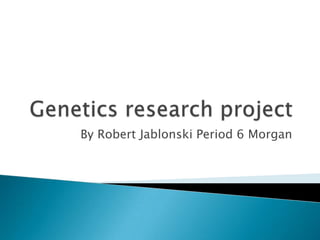
Genetics Research Project Summary
- 1. Genetics research project By Robert Jablonski Period 6 Morgan
- 2. When a dominant allele is present, the recessive allele is “masked” or is not present in the organism. (Example: The allele for freckles is dominant over non-freckles. The organism will have freckles if they have the allele for freckles Ff) When an organism is co-dominant, the offspring will then have both traits presant. Basic Principles of Genetics
- 3. A Punnett Square This chart shows how alleles are crossed to express traits.
- 4. Pedigree Charts A pedigree chart is a diagram that shows the appearance (phenotype) of an organism’s ancestors. They show the particular genes being passed time from ancestor to ancestor. A pedigree chart
- 5. Began on October 1st, 1990. Went on for 13 years and ended in April 2003. Intended to map human gene sequence and to use this information to treat gentic diseases. Some ethical, social and legal issues The privacy of those who contributed DNA to the project. The people who should have access to this genetic information. Ideas of if genes would judge a person’s personality. In 2008, GINA (Genetic Information Nondiscrimination Act) was signed into law to make sure that insurance companies cannot reject a person health insurance due to genetic issues. Human Genome Project
- 6. A disorder caused by the mutation of one gene. There are an estimated four thousand disorders caused by the mutation of a single gene. Some single gene disorders are sickle cell disease, muscular dystrophy, and cystic fibrosis. Single Gene Disorder
- 7. When there is an error in the 23 pairs of chromosomes in the body. These errors could be either too many chromosomes, or too little. Down syndrome- Most common chromosome disorder. One in every eight hundred babies affected. Causes intellectual disability, facial abnormalities, and other defects. Patau syndrome and Edwards syndrome- Also known as trisomies 13 and 18. Causes severe mental retardation and physical disorders. Most die before first birthday. One in sixteen thousand are born with Patau Syndrome and one in five thousand are born with Edwards syndrome. Chromosome disorders
- 8. A genetic disorder caused by the interaction of genes that affect an organism’s phenotype. Some diseases can be isolated (parents unaffected by disease, however child is) Some others affect just one specific race. Multifactoral Disorders
- 9. All of these disorders can contribute to both an organisms phenotype and there genes. All involve the heredity of parents and offspring. All involve genes and chromosomes. Single gene disorders would not affect chromosome count, whereas chromosome disorders would. Single gene disorders are when only one gene is mutated, whereas multifactoral disorders need multiple genes to be mutated. Similarities and differences
- 10. Genetic counselors are trained to give information to parents who are skeptical about their unborn children’s risks of genetic disorders. Karyotypes (Pictures of people’s chromosomes) can be used to predict a genetic disorder in children by looking if there are any chromosome abnormabilities in the parents. Genetic counseling and Karyotypes
- 11. Scientific advances in Cloning A timeline of cloning First cloned animals created in the late 1800’s by Hans Dreisch. He separated two sea urchin cells in a tube of salt water and then an adult sea urchin grew. In 1902 Hans Spemman experimented with salamanders. No major advances until 1952, when Philadelphia scientists cloned a frog embryo. In 1977, German scientists claimed to clone three mice, but this was found to be untrue. Also in 1978, an author claimed to have cloned a millionaire, however that too was a hoax. In 1996, Dolly the Sheep was cloned. She lived half the life a regular sheep would live. Also, she had several defects. In recent years, families have been able to clone dead dogs and cats.
- 12. Food Bourne Illness One reason biotech food or cloned food should be used is that no one has died from eating a Biotech food, whereas many people died from contaminated natural food according to Peter Day, director of Rutgers University's Biotechnology Center for Agriculture and the Environment. The CDC estimates that there are over 48 million cases of food bourne illnesses every year, and genetically engineering food would reduce the number.
- 13. Graph of biotech foods in U.S. This is a graph of the percentage of biotech food acres per food. Notice that Soybeans is just about 80 percent. Also, notice how all three foods dropped between 1999 and 2000.
- 14. The second generation of biotech foods will bring foods that have more nutrients, such as golden rice, which will give more vitamin A and soybeans will have more protein, says Elise Golan, D. Demcey Johnson and Robbin Shoemaker of the USDA. More nutrients
- 15. In recent estimates, it has been predicted that over one billion people in the world do not have enough food. According to Paul Collier, Professor of Economics at Oxford, the use of biotech food, though not popular, can end world hunger. Per Pinstrup-Andersen, H. E. Babcock Professor of Food, Nutrition and Public Policy at Cornell University and the 2001 World Food Prize Laureate says that “Many millions of people do not have access to sufficient calories and many more suffer from micronutrient deficiencies. Most of them are in rural areas and would benefit from productivity increases in agriculture. Furthermore, the world population will grow by more than two billion over the next 40 years.” Ending World Hunger
- 16. Biotech foods can also be used for drugs and other medications. All these drugs and medications will not be expensive for both the patients and the producers. Pharmaceuticals and drugs
- 17. In conclusion, I believe the government should provide funds for genetic food. This would help some food shortage problems among other issues and help end world hunger. Conclusion
- 18. http://library.thinkquest.org/20830/Frameless/Manipulating/Experimentation/Cloning/longdoc.htm http://roomfordebate.blogs.nytimes.com/2009/10/26/can-biotech-food-cure-world-hunger/ http://www.ornl.gov/sci/techresources/Human_Genome/home.shtml http://www.medterms.com/script/main/art.asp?articlekey=5494 http://library.cqpress.com/cqresearcher/document.php?id=cqresrre2001033000&type=hitlist&num=0 http://www.georgetownuniversityhospital.org/body.cfm?id=556426 http://www.genome.gov/10001772 http://www.ers.usda.gov/AmberWaves/November03/Features/futureofbiotech.htm http://www.agbioworld.org/biotech-info/articles/agbio-articles/GMmyths.html Works Cited